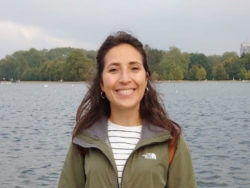24/04/2024

Aslıhan Ural Janssen is doing research as a PhD student at Ghent University within the framework of the Nutribudget project.
Agricultural activities led to considerable nutrient losses to the environment, causing pollution.
The EU Green Deal’s “Farm-to-Fork Strategy” has two significant ambitions on reducing fertiliser (mineral and organic) use by 20% and nutrient losses by 50% in 2030 ensuring the soil fertility. As part of the Circular Economy Package, the European Commission proposed to find solutions to convert organic wastes into high quality fertilisers in terms of performance and impacts.
Upcycling organic waste (e.g., agricultural, food waste) is among the most promising options to produce renewable bio-based fertilisers, reducing waste production and contributing to circular economy. However, the production and application processes might also have negative effects on the environment.
“The objective of my study is to assess the effects of bio-based fertiliser use on air and water pollution at basin (catchment) and European scales, and to explore mitigation options,” Aslihan explains.
This modelling study contributes to NutriBudget Project by two aspects.
First, quantifying the nitrogen (N) and phosphorus (P) flows mainly from agriculture to rivers and coastal waters across Europe can contribute to one of the aims of the project regarding integrated nutrient management.
Second, we identified the required reductions in nutrient losses to coastal waters to avoid coastal eutrophication by backcasting maximum allowable nutrient export by rivers based on an environmental target. This can support the formulation of effective nutrient management strategies in the EU by indicating how much and where (e.g., which river basins) we need to reduce pollution due to the excessive use of nutrients and nutrient losses to the environment.
To this end, a new MARINA-Nutrients model for Europe has been developed by linking an agricultural (MITERRA-Europe) and a water quality (MARINA) model.

The new MARINA-Nutrients model for Europe calculates nitrogen emissions to air (e.g., NH3, N2O) from agriculture, and nitrogen and phosphorus losses to surface waters from agricultural and non-agricultural (e.g., sewage systems, natural) sources in Europe (Water and air sources – WUR). Currently, the integration of bio-based fertilisers produced from animal manure processing is in progress.